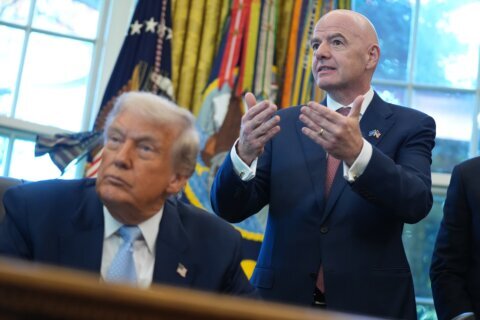JIM VERTUNO
AP Sports Writer
AUSTIN, Texas (AP) — Formula One’s third year at the U.S. Grand Prix in Texas is an excellent opportunity for the series to expand its footprint in a rich, largely untapped market for fans and money.
But looking inward, F1 has some troubles. Smaller teams are scrambling to keep up with the spending required to keep pace — spending that tops $400 million a year in some cases, easily the most expensive outlay in motorsports.
Two teams, Marussia and Caterham, won’t race in Austin because of financial problems. That leaves Sunday’s race with just 18 cars, F1’s smallest starting grid in nearly a decade, prompting new warnings from the governing body of international motorsports to control costs or risk losing sponsors and viability with fans.
“These failings once again acutely raise the question of economic balance” in F1, the FIA said this week, urging cost controls to “ensure the survival of the existing grid and attract new potential entrants.”
Marussia and Caterham were small players in an expensive sport that stages races around the globe in places like Monte Carlo and Abu Dhabi. No nation hosts more than one event. The teams that pull up the rear in F1 are typically derided as “backmarkers,” and both Marussia and Caterham spent almost all their time there.
In three seasons, Caterham had failed to win a single point and Marussia’s grand total of two was corralled by Jules Bianchi, the talented young French driver who was severely injured last month at the Japanese Grand Prix and remains in a hospital in critical but stable condition.
On Friday, there was no sign the teams even existed at the Circuit of the Americas. One paddock garage sat empty while another was taken over by tire supplier Pirelli.
Caterham driver Marcus Ericsson sat in the media center cafeteria for lunch after watching the day’s first practice session. Instead of his race suit, he wore blue jeans and a black sweater, minus any sponsorship advertising.
“It’s a strange feeling … I was really excited about this race in Austin,” Ericsson said. “It’s very sad to be here and not race.”
Marussia and Caterham are just the latest teams to struggle. In 2012, the HRT team folded after two years. Things got so bad that year that its drivers came to Austin denying rumors the team was so broke it couldn’t afford spare parts and the cars were dangerous to drive.
“We miss them,” said Red Bull driver Sebastian Vettel, the four-time defending world champion who is out of the title chase this season. “It’s always nice to see other cars on the track. Surely, it’s not a nice progression, but I think we’ve seen now over the years some of the smaller teams are struggling to find the money to manage their seasons.”
Estimates of spending by the wealthiest teams, such as Ferrari, can top $400 million per year. According to 2013 figures from Formula Money, which covers the finances of F1, the top IndyCar teams spent about $15 million annually. In NASCAR, top team budgets are around $25 million.
“The sport has gone into a direction that can’t be kept up,” said Sauber team principal Monisha Kaltenborn, whose team is struggling to compete.
Marussia, Caterham and HRT all came into F1 at a time the sport looked to be heading toward a spending cap of about $65 million. But the cap was rejected under pressure from bigger, wealthier teams and the small teams were forced to spend massive amounts of money to keep up.
“They had every expectation of different rules,” said Nick Craw, president of the FIA Senate. “It’s very sad, but Darwinism is alive and well. There are other people coming into the sport who will probably not have the same handicaps.”
Formula One awaits the 2016 debut of Haas F1. Owner Gene Haas, who is co-owner of Stewart-Haas Racing in NASCAR, decided to start an American-based team in F1. Haas had originally hoped to race in 2015 but decided 2016 was a more realistic launch.
The last U.S.-based team was Parnelli Jones Racing in 1974-76, when Mario Andretti drove, and an attempt to field another American team folded almost as soon as it started in 2010.
“The farther along I get, the better I feel about things,” Haas said before Marussia and Caterham collapsed. “I’ve been involved in a successful NASCAR team … I have a successful business involved in manufacturing. All those things seem to say that Formula One is a natural stepping stone toward the ultimate event.”
Haas said it will probably take putting his cars on the track to silence skeptics that he’ll actually race F1. He declined to say how much he’s spent to start his team, but noted some of his contracts include some “big numbers.”
“It’s a big undertaking. People are looking for us to fail. It’s a natural skepticism,” Haas said.
If new teams don’t come on the grid, the larger, wealthier teams could consider running three cars, an idea that seemed to be embraced by several drivers this week. Adding a third car could keep talented but inexperienced drivers in the series and give them a chance to work with the best technology in the world.
“Formula One is really limited, the spaces where you can go and where you can actually win during the year, so it can create a bit more opportunity for drivers,” said Force India’s Sergio Perez. “I think we should all help this sport to get better.”
___
AP Auto Racing Writer Jenna Fryer in Charlotte, North Carolina, contributed.
Copyright 2014 The Associated Press. All rights reserved. This material may not be published, broadcast, rewritten or redistributed.







